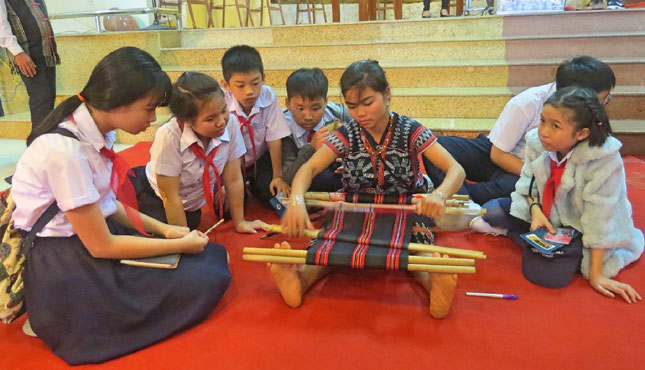Exploring different cultures in fascinating events at Museum of Da Nang
Over recent years, apart from enriching its collection of exhibits on display, the Museum of Da Nang has attached importance to organsing a chain of diverse programmes offering real-life cultural experiences for both locals and visitors.
 |
| Local pupils eagerly learning about a certain traditional Vietnamese craft introduce at the museum |
Within the framework of this year’s main programmes, ‘Laos Day 2018’, which recently took place at the museum, has attracted the great deal of attention from the general public, especially local youths.
This event aimed to celebrate the traditional Lao New Year, Songkran or Pii Mai, and the 56th anniversary of diplomatic ties between the two countries as well.
‘Laos Day 2018’ introduced the general public to the distinctive Lao cultural values, creating an interesting rendezvous for the Lao students who are living and studying in the city, and help to enhance the time-honoured friendship between the 2 countries.
Notable amongst a series of fascinating events are a photo contest on the land and people of Laos, a performance of ‘Lamvong’ (traditional Lao dance) and national costumes, and a display of Lao musical instruments and cuisine.
Visitors were very eager to enjoy the traditional customs of Lao people as they were invited to wear threads on their wrists, and see how Lao women twist their hair in a bun.
Another landmark event is a ceremony for raising the lunar New Year pole (‘Cay Neu’ in Vietnamese) which is scheduled to take place at the museum on 30 April and 1 May.
This ritual has been practiced for a long time in the Xo Dang ethnic minority group in Quang Nam Province’s mountainous Nam Tra My District.
The lunar New Year pole is a piece of a bamboo 5 or 6 yards long is stripped bare excerpt for a little bunch of leaves. Near the top is suspended a round bamboo frame holding a few little fish and bells made of baked clay that tinkle softly in the wind. Beneath this frame are votive gifts and some thorny branches.
At the top of the New Year tree, a small kerosene lamp is lit at night. The New Year tree marks the way for the ancestor’s spirits who came back from the other world to enjoy New Year with the living. Evil spirits are scared away by the thorns and the tinkling of the bells. Other precautions are also taken: villagers use lime powder to sketch a drawn bow on their courtyards. The arrows of the bow are supposed to frighten away evil spirits.
Last year, the museum hosted a festival honouring the traditional crafts from Da Nang and Quang Nam Province, which received high applause from the general public, especially local pupils.
The museum’s Director, Mr Huynh Dinh Quoc Thien, happily said many local pupils showed their keen interest in gaining a deeper insight into traditional Vietnamese crafts at the festival. In particular, they were interested in learning about how to make conical hats with the help from artisans.
Such meaningful programmes offering real-life cultural experiences for visitors indeed help to inspire them to cherish and preserve the national cultural heritage, as well as to facilitate traditional Vietnamese craft villages to widely publicise their time-honoured products to the general public.